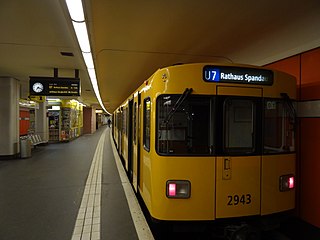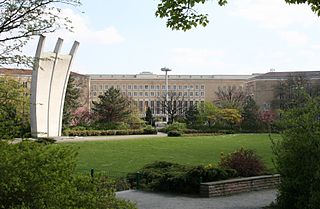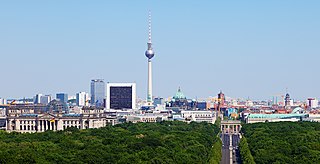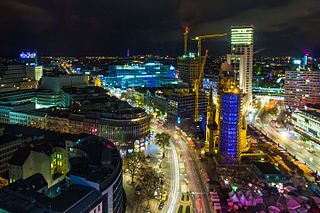
Rathaus Schöneberg is the city hall for the borough of Tempelhof-Schöneberg in Berlin, Germany. From 1949 until 1990 it served as the seat of the state senate of West Berlin and from 1949 until 1991 as the seat of the Governing Mayor.

Tempelhof is a locality of Berlin within the borough of Tempelhof-Schöneberg. It is the location of the former Tempelhof Airport, one of the earliest commercial airports in the world. The former airport and surroundings are now a park called Tempelhofer Feld, making it the largest inner city open space in the world.

U6 is a 19.9 km (12.4 mi) long rapid transit line on the Berlin U-Bahn with 29 stations. It runs in a north-south direction from the Berlin locality of Tegel in the north via Friedrichstraße to Mariendorf, a locality in the southern part of the city. It is one of the five large profile ("Großprofil") lines.

The U7 is a rail line on the Berlin U-Bahn. It runs completely underground for a length of 31.8 kilometres (19.8 mi) through 40 stations and connects Spandau, via Neukölln, to Gropiusstadt and Rudow. The U7 was originally the south-eastern branch of the Nord-Süd-Bahn (U6) that ran between the branching point at Belle-Alliance-Straße (Mehringdamm) and Grenzallee; however, in the 1960s, this stretch was separated from the rest of the line and extended at each end to form a new line.

Schöneberg is a locality of Berlin, Germany. Until Berlin's 2001 administrative reform it was a separate borough including the locality of Friedenau. Together with the former borough of Tempelhof it is now part of the new borough of Tempelhof-Schöneberg.

Friedenau is a locality (Ortsteil) within the borough (Bezirk) of Tempelhof-Schöneberg in Berlin, Germany. Relatively small by area, its population density is the highest in the city.

Motzstraße is a street in the Berlin borough of Tempelhof-Schöneberg. It runs from Nollendorfplatz via Viktoria-Luise-Platz in Schöneberg to Prager Platz in Wilmersdorf.

Marienfelde is a locality in southwest Berlin, Germany, part of the Tempelhof-Schöneberg borough. The former village, incorporated according to the Greater Berlin Act of 1920, today is a mixed industrial and residential area.

Berlin Heidelberger Platz is a railway station in the Wilmersdorf district of Berlin. It is served by S-Bahn lines S41, S42 and S46 and U-Bahn line U3.

Bayerischer Platz is a Berlin U-Bahn station on the U4 and the U7 lines. The station is located under the square of the same name in the centre of the Bayerisches Viertel neighbourhood in Schöneberg. The U4 station opened with the rest of the line on 1 December 1910 and is now a protected historic landmark; the U7 part of the station opened on 29 January 1971.

Voßstraße is a street in central Berlin, the capital of Germany. It runs east–west from Ebertstraße to Wilhelmstraße in the borough of Mitte, one street north of Leipziger Straße and very close to Potsdamer Platz. It is best known for being the location of Hitler's new Reich Chancellery complex, and the bunker where he spent his last days.

Bundesautobahn 100 is an Autobahn in Germany.

Attilastraße station is on the Berlin–Dresden railway in the district of Tempelhof in the Berlin borough of Tempelhof-Schöneberg. It is served by Berlin S-Bahn line S2. It was opened in 1895 under the name of Mariendorf and electrified in 1939. It was renamed Attilastraße in 1992.

Bus transport is the oldest public transport service in Berlin, the capital city of Germany, having been introduced in 1846. Since 1929, services have been operated by the Berlin Transport Company, although during the Cold War-era division of the city they operated in West Berlin only. In East Berlin the public transport agency split off from the BVG and rebranded as BVB, operating the busses in the soviet sector of Berlin.

Lichtenrade is a German locality (Ortsteil) within the borough (Bezirk) of Tempelhof-Schöneberg, Berlin. Until 2001 it was part of the former borough of Tempelhof.

Platz der Luftbrücke is a landmarked square and transport node in Berlin, Germany, on the border between the localities of Tempelhof and Kreuzberg. The entrance to the former Tempelhof International Airport is on the square. The buildings around the square are now mostly government agencies, in particular police headquarters. The name of the square commemorates the Berlin airlift of 1948/49 in which Tempelhof was the main airfield used; the Berlin Airlift Monument is in the square.

Berlin's history has left the city with an eclectic assortment of architecture. The city's appearance in the 21st century has been shaped by the key role the city played in Germany's 20th-century history. Each of the governments based in Berlin—the Kingdom of Prussia, the 1871 German Empire, the Weimar Republic, Nazi Germany, East Germany and the reunified Federal Republic of Germany—initiated ambitious construction programs, with each adding its distinct flavour to the city's architecture.

City West is an area in the western part of central Berlin. It is one of Berlin's main commercial areas, and was the commercial centre of former West Berlin when the city was divided by the Berlin Wall.

The Berlin U-Bahn originated in 1880 with Werner Siemens' idea to build an urban railway in Berlin. During the nine years after the German Empire was founded, the city's population grew by over one-third and traffic problems increased. In 1896, Siemens & Halske began to construct the first stretch of overhead railway. On 1 April 1897, the company began construction of an electric underground railway. The Berliner Verkehrs Aktiengesellschaft (BVG) was formed in 1928, and took over further construction and operation of the network. In 1938, the company was renamed Berlin Transport Company; the original acronym, however, remained. Since 1994, the BVG has been a public company.
The Mölln arson attack was the first fatal case of far-right extremists setting fire to migrants' homes in Germany, and one of the earliest cases of Right-wing terrorism in the country's post-unification history. On the night of 22 November 1992, 2 German men with neo-Nazi ties set fire to the 2 houses of Turkish families in Mölln, in Schleswig-Holstein, Germany. 3 Turks died in the attack while 9 others were injured.

























